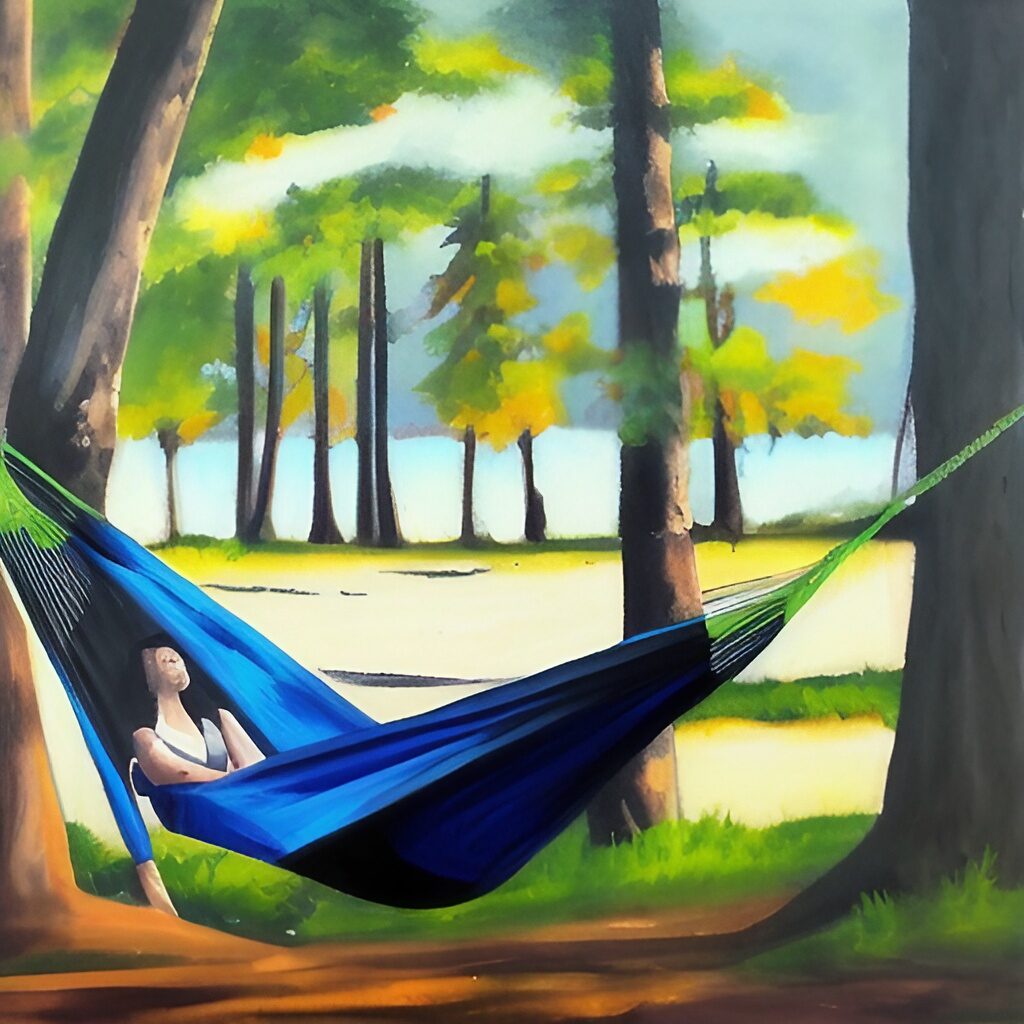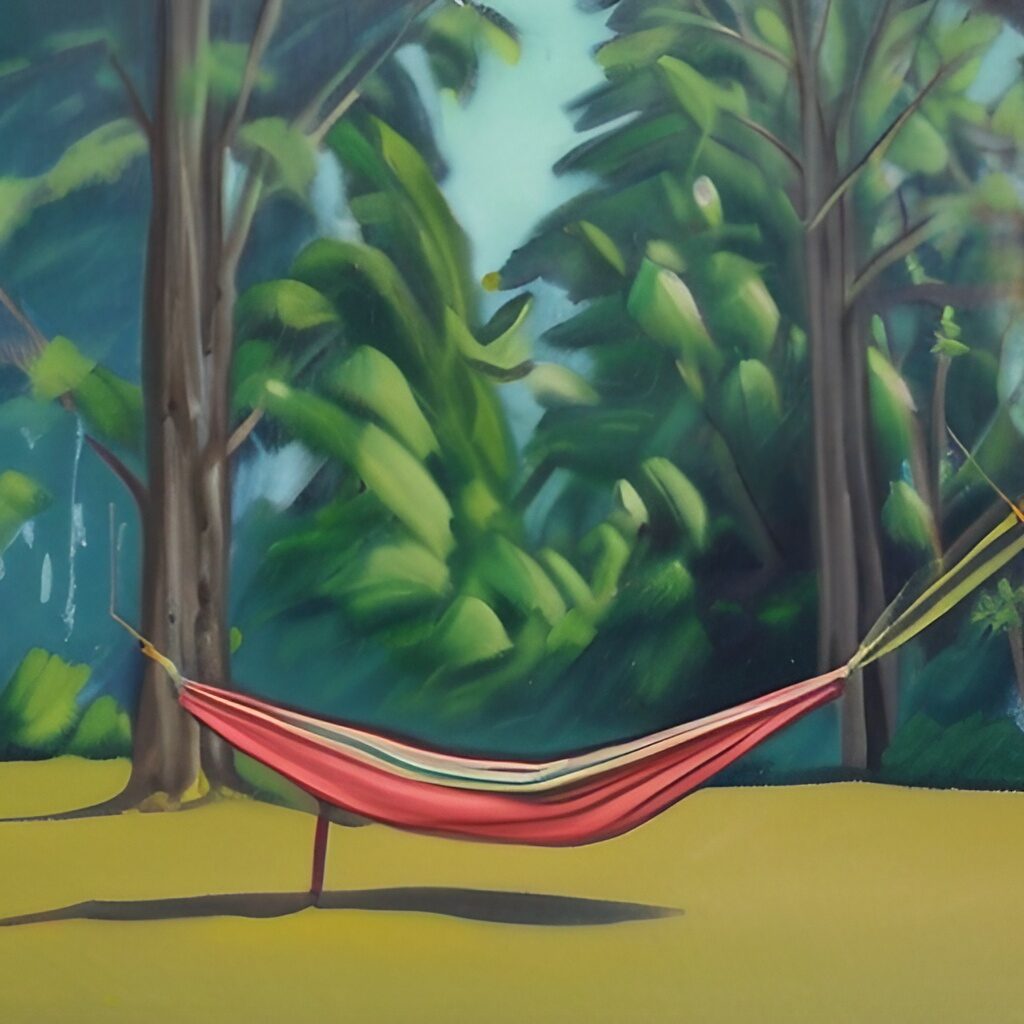
Hammock camping is a fantastic way to stay close to nature and brave the elements. However, you still need to stay warm while you’re doing it: sleeping pads and underquilts can help.
Hammock Sleeping Pad Vs Underquilt – A sleeping pad is highly versatile and can be used in or out of your hammock. It provides warmth and padding and is affordable. However, underquilts provide wrap-around warmth and more versatility, but they are slightly heavier and pricier.
It’s not that simple, though. To determine which sleep aid is better, I’ve combined my experience and research skills to create this detailed guide for you.
| Feature | Sleeping Pad | Underquilt |
| Weight | Varies; Can be lighter than underquilt | Light; Rarely more than 2lbs |
| Comfort | Pad moving can be uncomfortable | Very comfortable |
| Warmth | Depends on R-value | Depends on the season rating |
| Versatility | Mildly versatile for sleeping | Very versatile for night and day use |
| Packed Size | Compact; Water bottle sized | Compact, larger than a sleeping pad |
| Convenience | Can be difficult to keep in place | Usually easy to set up |
| Price | Varies; can be affordable or expensive | Expensive |
- Sleeping Pad Pros and Cons – Sleeping Pad vs Underquilt in Hammocks
- Underquilt Pros and Cons – Sleeping Pad vs Underquilt in Hammocks
- Weight – Sleeping Pad vs Underquilt in Hammocks
- Comfort – Sleeping Pad vs Underquilt in Hammocks
- Warmth – Sleeping Pad vs Underquilt in Hammocks
- Versatility – Sleeping Pad vs Underquilt in Hammocks
- Packed Size – Sleeping Pad vs Underquilt in Hammocks
- Convenience – Sleeping Pad vs Underquilt in Hammocks
- Price – Sleeping Pad vs Underquilt in Hammocks
- Do I Need a Sleeping Bag With A Sleeping Pad? – Sleeping Pad vs Underquilt in Hammocks
- Do I Need a Sleeping Bag With An Underquilt? – Sleeping Pad vs Underquilt in Hammocks
- Alternatives to Sleeping Pads and Underquilts – Sleeping Pad vs Underquilt in Hammocks
- Conclusion: Which One Wins? – Sleeping Pad vs Underquilt in Hammocks
- Frequently Asked Questions – Sleeping Pad vs Underquilt in Hammocks
Sleeping Pad Pros and Cons – Sleeping Pad vs Underquilt in Hammocks
There are various types of sleeping pads, but the most common type for heat retention and small pack size is the self-inflating pad. For that reason, I’ll be using that type of sleeping pad to determine the pros and cons below.
The Pros – Sleeping Pad Pros and Cons
- Beginner-friendly: Most beginners already have a sleeping pad for their tent, so it’s easy to start using it in the hammock, too
- Extremely compact: Some sleeping pads can roll up into the size of a water bottle
- Very light: Sleeping pads often weigh less than 3 pounds, although some can be heavier
- Affordable: Some very high-quality sleeping pads are wonderfully budget-friendly
- Hold heat well: High R-Value pads have great insulation
The Cons – Sleeping Pad Pros and Cons
- Not secure: Your sleeping pad can move around under you, and you might fall off it
- Not breathable: If you sweat at night, you’ll stay damp until morning
- Very narrow: Your pad will often be narrower than your hammock, so it will fit strangely
Underquilt Pros and Cons – Sleeping Pad vs Underquilt in Hammocks
Underquilts are designed to hang under your hammock rather than go inside it, so they’re quite different from sleeping pads.
The Pros – Underquilt Pros and Cons
- Won’t move around: The underquilt is secured to the underside of the hammock, so you can move around, and it won’t move with you
- Highly insulated: All underquilts are well-insulated to keep heat loss at bay
- Comfortable: You won’t feel the underquilt under you the way you’d feel a sleeping pad
- Wrap-around warmth: The warmth comes up around your sides
The Cons – Underquilt Pros and Cons
- Not the best for all hammocks: Some people have difficulty with underquilts in gathered-end hammocks, but others find them difficult in bridge hammocks
- Heavier than sleeping pads: Not great if you need to hit the trail with your gear
- Pricey: You can get good pads for lower prices, but good underquilts don’t come cheap
Weight – Sleeping Pad vs Underquilt in Hammocks
Winner: Sleeping pad
Sleeping pads are widely known in the camping community for being lighter than underquilts.
That said, some people don’t mind the weight difference. You may not mind, either. Your choice should be based on your needs as well as your preferences—that will help you determine if the higher weight of an underquilt is worth it for you.
However, sleeping pads don’t always win here. For example, regular self-inflating sleeping pads are much heavier than underquilts. Let’s compare products:
- WELLAX UltraThick FlexFoam Sleeping Pad—5lbs 15oz
- GRAND TRUNK 360 ThermaQuilt—1lbs 13oz
So, you have to be careful with your selection and choose an ultralight pad, as that’s what most experienced campers are likely to have.
This Gear Doctors sleeping pad only weighs 1lbs 1oz, which makes it almost a whole pound lighter than the underquilt.
So shop smart! Two pads can have a similar R-value, thickness, and price while weighing enormously different amounts. Underquilts have less weight variation, so they’ll rarely exceed 2 lbs, but that’s still heavier than some of the pads on the market.
Comfort – Sleeping Pad vs Underquilt in Hammocks
Winner: Underquilt
I can’t tell you what you’ll find more comfortable, but I can tell you that I prefer underquilts. I feel like I have more freedom to move around without a pad, and I’m not afraid of slipping off the pad at night.
Lots of fellow campers agree.
Some people are still on the fence about the topic, and that’s fine. There’s not a huge difference between a pad and an underquilt to most people, but there are others that prefer the quilt enough to give up pads in hammocks for good.
I always recommend trying both options and seeing which one you like best. However, you should also take note of the pros and cons at the start of the article, as many of them will tie into how comfortable a pad is vs an underquilt.
Warmth – Sleeping Pad vs Underquilt in Hammocks
Winner: It varies
It’s difficult to nail down which is warmer when it comes to underquilts and sleeping pads. Their warmth is measured in different ways, and it’ll vary per product.
Underquilts – Warmth
Underquilts are often stated to be 4-season underquilts, winter underquilts, spring and fall underquilts, and more. They have different amounts of insulation in them, and it determines how much heat they’ll hold and how warm they’ll keep you.
Their main benefit in terms of heating is that they provide wrap-around warmth as they’re under you and they come up around the sides of the hammock. This is a benefit that sleeping pads lack.
A lot of people figure out what underquilt they need for warmth via trial and error, and some find them warmer than expected while others feel they’re underwhelming.
However, sleeping pads are far easier to pick in terms of how warm you’ll be.
Sleeping Pads – Warmth
Sleeping pad insulation is measured on a scale known as R-value.
Here’s a helpful table:
| Range | 60°F/16°C | 40°F/4°C | 20°F/-7°C | 0°F/-18°C | -20°F/-29°C | -40°F/-40°C |
| R-Value | 0.5-1 | 1.5-2 | 2.5-3 | 3.5-4 | 4.5-5 | 5.5-6 |
If you want to go deep into how R-value works, you can read that here.
Basically, when you read the R-value of a sleeping pad, then you know what temperature conditions you’ll be able to withstand. You might be chilly, you might be “okay,” or you may be extremely warm, depending on the rest of your sleep setup.
Experimenting with different sleeping pads and underquilts is the only way to figure out which one is warmer for you.
Versatility – Sleeping Pad vs Underquilt in Hammocks
Winner: Underquilts
A lot of people feel that sleeping pads are more versatile than underquilts, and this is true in a way. Sometimes you’ll be camping and you won’t find a suitable area for your hammock. You’ll be able to use your sleeping pad on the ground in this case.
However, that’s all you can use your sleeping pad for in most cases. You can only use it to sleep on top of it whether you’re in your hammock or not.
Underquilts are much more versatile than that.
Can you sleep on an underquilt if you can’t use your hammock? You could, but I won’t recommend it. But you can use it on the ground in other situations. Let’s look at what else it can be used as:
- Picnic blanket
- Used as an overquilt if you lose/forget yours
- Emergency shelter from the rain if nothing else is available
- Extra blanket for sleeping
- Shawl to wrap around you if your jacket isn’t warm enough during the day
Packed Size – Sleeping Pad vs Underquilt in Hammocks
Winner: Sleeping pads
The packed size of these products varies. To keep this fair, let’s compare the light sleeping pad and the underquilt from earlier.
The Gear Doctors sleeping pad packs extremely small: only 8.5 inches long and 3 inches in diameter. Many inflatable and self-inflating sleeping pads can pack down to a similar size.
The RAND TRUNK 360 ThermaQuilt is around 15 inches long and 23 inches in circumference when it’s in its stuff sack. This is average enough, with many other underquilts compressing to similar sizes.
There’s a lot of fabric in an underquilt, so the packed size will always be larger than most sleeping pads. Foam sleeping pads are the exception, as they roll into long tubes and are much bigger than underquilts when packed.
Convenience – Sleeping Pad vs Underquilt in Hammocks
Winner: Underquilts
Convenience is another subjective factor. Let’s look at the few facts associated with it:
- You can fall off sleeping pads, but not underquilts
- It can be difficult to get into a hammock when there’s a sleeping pad moving around in it
- Attaching an underquilt to a hammock is mostly easy
- If your sleeping pad is punctured you’re out of luck, but it’s easy to lay an underquilt into a hammock if the strings that attach it to the hammock snap
It looks like underquilts take the lead in terms of convenience when you think about it in specific scenarios.
The size and weight of both pieces of equipment also factor into their convenience factor, so keep that in mind when you’re choosing a product based on how easy it is for you to use.
Despite underquilts seeming to be the winner here, you can make sleeping pads a little easier to use in your hammock. It’s time to ask, should sleeping pads go inside sleeping bags?
If you place one inside your sleeping bag then you won’t fall off it, it won’t move around, and it’s unlikely to be punctured whether you’re on the ground or in the hammock.
Price – Sleeping Pad vs Underquilt in Hammocks
Winner: Sleeping pads
Sleeping pads are generally the most cost-effective option.
There are sleeping pads and underquilts available at various price points. If you do a general search without being brand-specific, then you’ll find both products ranging anywhere from $30 to over $100.
The quality difference at different price points and between brands will vary, so let’s look at a popular brand for camping gear: REI.
REI underquilts are all over $100 and go up as high as almost $300. They’re expensive because they’re long-lasting and high-quality, and there’s a huge performance difference between a REI underquilt and an inexpensive one from any other brand.
REI sleeping pads have a much lower price tag. Some are under $50, but they’re the very thin ones. They inch towards $100 as they get thicker, and many of the highest-quality pads are over $100.
There are a few pads over $200, but any over $300 are double sleeping pads. With the lower price for the quality and the wider price range available, sleeping pads are by far the more affordable option.
Do I Need a Sleeping Bag With A Sleeping Pad? – Sleeping Pad vs Underquilt in Hammocks
You don’t need a sleeping bag with a sleeping pad. You can use a wool blanket or an overquilt instead. However, using a sleeping bag is highly recommended as they’re well-insulated and work particularly well in colder weather.
When comparing a sleeping bag vs sleeping pad, I determined that you’ll have the best time if you use both pieces of gear, but you can go without one or the other if the situation calls for it.
Use your best judgment about how cold and comfortable you’ll be if you choose to go without one or the other.
Do I Need a Sleeping Bag With An Underquilt? – Sleeping Pad vs Underquilt in Hammocks
Using a sleeping bag with an underquilt is recommended but not necessary. You’ll need some kind of protection from the cold over you, but you can use a blanket or overquilt instead.
Sleeping bags add extra padding, and you don’t always need that padding in a hammock. The bag is really there to add warmth.
That said, a little extra padding under the weight of your body isn’t going to hurt, and it may make you feel more comfortable even if you weren’t uncomfortable without one.
Alternatives to Sleeping Pads and Underquilts – Sleeping Pad vs Underquilt in Hammocks
There are plenty of options for you if you dislike both sleeping pads and underquilts. You may have to get a little experimental, but these alternatives can get the job done.
Sleeping Bags – Alternatives to Sleeping Pads and Underquilts
You can use a thick winter sleeping bag without anything else in a hammock, but you may end up feeling too cold underneath. There’s a lot of cold air that can circulate under your hammock, and it won’t feel very nice if there’s a chill under your body.
Emergency Blankets – Alternatives to Sleeping Pads and Underquilts
Emergency blankets are designed to reflect body heat back to you, so using a few of them in your hammock can help keep you warm. You can sleep on top of one of them and place another over you like a quilt.
Wool Blanket – Alternatives to Sleeping Pads and Underquilts
People often think of wool blankets in the context of wool blankets vs sleeping bags, but you can use a blanket with or without a bag while you’re in a hammock.
Laying a wool blanket into the hammock adds further protection from the cold, so it’s a great alternative to a pad or underquilt. They’re not the thickest things in the world, but some insulation is better than none.
Overquilt – Alternatives to Sleeping Pads and Underquilts
Overquilts have lots of padding and insulation so they can make you warmer and more comfortable. Although they’re designed for use on top of you, you can still use them underneath you.
Line the inside of the hammock with the quilt, then get on top of it. It may move around a little, but the parts that are under you will stay in place.

Conclusion: Which One Wins? – Sleeping Pad vs Underquilt in Hammocks
There’s no clear winner here, but there are certainly winners in different categories that you can use to determine which sleep setup would be better for you.
People generally prefer underquilts, and it’s not hard to see why, but there’s also a great argument to be made for using a sleeping pad instead.
At the end of the day, there’s no right answer. But I hope the criteria above have given you enough information to make the right choice for your circumstances.
Frequently Asked Questions – Sleeping Pad vs Underquilt in Hammocks
What are the Different Kinds of Camping Hammocks that I Can Use? – FAQs
There are several types of camping hammocks available, each with its own set of features and advantages.
Here are some of the most common camping hammocks:
- Traditional Camping Hammocks: These are no-frills hammocks that are ideal for backpacking trips or casual camping. They are lightweight and simple to assemble.
- Double Camping Hammocks: These hammocks are designed for two people and have more space and weight capacity than traditional models.
- Expedition Hammocks: These heavy-duty hammocks are intended for serious outdoor enthusiasts who require a long-lasting and dependable shelter in harsh conditions.
- Jungle Hammocks: These specialized hammocks have mosquito netting and a rainfly built in, making them ideal for camping in humid or rainy conditions.
- Ultralight Hammocks: Made of superlight materials like nylon, these hammocks can be packed down to a very small size, making them ideal for backpacking or minimalist camping trips.
- Bridge Hammocks: These unique designs make use of spreader bars to create a flatter sleeping surface that many people find more comfortable than traditional models.
Consider factors such as weight capacity, ease of setup, durability, comfort level, and any additional features such as mosquito netting or rainfly coverage when purchasing a camping hammock.
What are the Most Essential Differences Between Sleeping Pads and Underquilts? – FAQs
The primary distinctions between sleeping pads and underquilts are as follows:
- Insulation: Sleeping pads provide ground insulation, whereas underquilts provide insulation from beneath the hammock.
- Comfort: Sleeping pads provide a more cushioned sleeping surface, whereas underquilts contour to the shape of your body and provide warmth without adding bulk.
- Weight and Packability: Sleeping pads are typically larger and heavier than underquilts, which are designed to fold up small for easy transport.
- Ease of Use: Sleeping pads are generally easier to set up and use because they can be simply laid out on the ground beneath your hammock. Underquilts necessitate additional setup time and may necessitate the use of specialized hardware or attachments.
- Temperature Range: Because they provide more complete insulation around the entire body, underquilts are typically better suited for colder temperatures. In extremely cold weather, sleeping pads may not be sufficient.
Finally, the decision between a sleeping pad and an underquilt will come down to personal preference, camping conditions, and individual comfort and warmth requirements.
What Makes for Good Hammock Camping Conditions? – FAQs
The following are examples of ideal hammock camping conditions:
- Appropriate Trees: To hang a hammock, you’ll need two sturdy trees that are spaced properly apart. Look for trees with trunks that are at least six inches in diameter and are spaced at least 12-15 feet apart.
- Flat Ground: Check that the ground beneath your hammock is relatively flat and free of rocks or other obstacles that could make sleeping uncomfortable.
- Weather Conditions: Mild temperatures with little to no wind or precipitation are ideal for hammock camping. Setting up your hammock during a thunderstorm or high wind can be dangerous.
- Location: Select a location away from high traffic areas to reduce noise and disturbance at night. If possible, choose a location with a scenic view or natural features such as waterfalls or lakes.
- Considerations for Safety: When choosing a camping location, always prioritize safety. Avoid areas where there are potential hazards, such as loose rocks, unstable soil, or steep drops.
You can ensure a safe and enjoyable hammock camping experience by keeping these factors in mind and doing some research on local camping regulations and guidelines.














